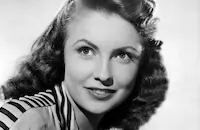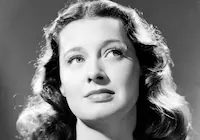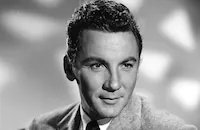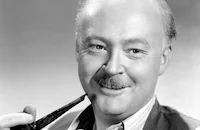Man in the Saddle
Brief Synopsis
Cast & Crew
Andre Detoth
Randolph Scott
Joan Leslie
Ellen Drew
Alexander Knox
Richard Rober
Film Details
Technical Specs

Synopsis
At Skull Ranch, wealthy cattleman Will Isham prepares for his wedding to ambitious Laure Bidwell. In the town saloon, Isham's new foreman, Fay Dutcher, offers to treat everyone, but many of the local men, including Laure's former beau, rancher Owen Merritt, refuse because of their resentment of Isham's ruthless domination of the territory. Owen leaves to find Laure and when he asks if she is sure about her decision to marry Isham, she assures him she is, having grown tired of waiting for Owen. Meanwhile, Dutcher hires Hugh Clagg as a side gun, to help protect Isham. At the wedding party that evening, Clagg forces his attentions on schoolteacher Nan Melotte, who reluctantly agrees to accompany him to a dance that weekend. Meanwhile, Isham meets privately with Pay Lankershim and forces him to sell his ranch, which separates Skull Ranch from Owen's Christmas Creek Ranch. The next day, Nan brings her small herd of cattle to Owen's ranch to join his drive to market and warns him that Lankershim's sell-out may prove dangerous. That night, Dutcher and his men purposely stampede Owen's cattle and although Owen and his men manage to halt the steers, ranch hand Juke Virk is found trampled to death. Upon examination, however, it is discovered Juke was shot. Outraged over his brother's death, George Virk rides into town, and finding Dutcher at the saloon, accuses him of murder. In the ensuing shootout, Skull hand Ned Bale is killed. Later that day, Laure rides out to warn Owen not to oppose Isham and tells him to leave the country. Owen refuses, until Laure offers to go with him. That evening Owen's ranch is abruptly attacked and George is found dying on the porch. Owen retaliates with an assault on the Skull bunkhouse, but is forced to retreat with Dutcher's arrival. The next night Owen sneaks back onto Skull, but is discovered by Dutcher and Clagg, who wound him. Hearing the shooting from her small ranch nearby, Nan goes to help and brings Owen to her home. The next day, Clagg arrives at Nan's to escort her to the dance and becomes incensed to discover she has helped Owen. Knowing Clagg will bring Dutcher and his men, Nan takes Owen to an abandoned family cabin high in the mountains. At Skull, Laure becomes disturbed by Isham's use of violence and when the men depart, she disobeys her husband and sneaks off the ranch in search of Owen. Meanwhile, Clagg tracks Nan's buckboard trail into the mountains and discovers the hideout, where he jealously accuses Nan of carrying on romantically with Owen. The men engage in a brutal fistfight, and before Clagg finally flees when Nan shoots at him. He returns to Skull Ranch, where Isham stews over Laure's absence. When Isham overhears Clagg telling Dutcher that Owen is in the mountains with a woman, he believes her to be Laure. In a rage, he shoots Clagg repeatedly, even as the dying man insists the woman is not Laure. Owen, meanwhile, has returned to Christmas Creek, where Bourke has captured Skull hand Lee Repp, who confesses that Isham hired Dutcher to kill Owen and ordered the murder of the Virks. He also details Clagg's slaying. In town, Nan runs into Laure, who anxiously inquires about Owen, then seeks out Isham. As a wind storm begins, Owen brings Repp to the sheriff to sign a statement regarding Isham. Owen learns Isham and Laure are at the hotel and goes to tell them that if they give up Skull and leave the country they might survive. Realizing she has lost Owen, Laure vows to remain faithfully with Isham and he agrees to Owen's proposal. As Isham, Owen and Laure descend to the lobby, Dutcher bursts in and despite Isham's order to halt, shoots at Owen. Isham intercedes and is shot. As he dies and Owen and Dutcher shoot it out, Isham tells Laure never to sell Skull. Hearing the shots, Nan rushes into the hotel and Dutcher briefly uses her as a shield to escape. Owen chases him into the windy street and shoots and kills him. Nan then rushes out to Owen and they embrace.

Director

Andre Detoth
Cast

Randolph Scott

Joan Leslie

Ellen Drew

Alexander Knox
Richard Rober
John Russell

Alfonso Bedoya

Guinn "big Boy" Williams

Clem Bevans

Cameron Mitchell
Richard Crane
Frank Sully
George Lloyd

James Kirkwood
Frank Hagney

Don Beddoe
Reed Howes
George Wallace
Peter Virgo
Rosa Turich
David O. Mccall
Frank Ellis
Charles Rivero
Dorothy Phillips
Ada Adams
Curly Gibson
Robert E. Burns
William Nye
Frank O'connor
Tennessee Ernie
Crew
George Brooks
Harry Joe Brown
Francis Cugat
George Duning
Kenneth Gamet
Frank Goodwin
Charles Lawton Jr.
Harold Lewis
Ralph Murphy
Charles Nelson
Willard Reineck
Randolph Scott
Herbert Stewart
Morris Stoloff
Frank [a.] Tuttle

Film Details
Technical Specs

Articles
Man in the Saddle
Man in the Saddle (1951) was the first of six Westerns Scott filmed with director Andre De Toth, and if they are not as fondly remembered or critically acclaimed as the seven movies Scott made with director Budd Boetticher later in the decade, they nevertheless served to establish him in the genre and boost his popularity.
The story casts Scott as a peaceful farmer and rancher who has to resort to violence to defend himself and his property against a powerful and ruthless land baron. In the process Scott's character, Owen Merritt, is caught between two women, the ambitious Laurie Bidwell (Joan Leslie) and the down-to-earth Nan Melotte (Ellen Drew).
The Scott Westerns proved to be a boon for De Toth as well. The Hungarian-born director made his first film in America in 1943 and released only a handful of pictures before his first oater, Ramrod (1947). The Scott Westerns helped establish him as an expert at tough, hard-edged action pictures, whether set in the West or the world of urban crime. He also had a penchant for realistically portrayed violence in his movies.
In addition to his six pictures with Scott, praised for injecting adult storylines and complex characterizations into the Western, De Toth is best known for his noir melodrama Guest in the House (1944); the aviation adventure Slattery's Hurricane (1949), which featured his wife at the time, Veronica Lake; and the 3-D horror film House of Wax (1953).
In later years, De Toth wrote humorously about his professional relationship with Scott, who he described as a "blue-book millionaire...with a hobby which he thought was acting." Of producer Brown, he noted his heavy drinking, "mundane taste" and "nickel-and-dime" approach to his job. De Toth claimed neither Brown nor Scott read scripts (They preferred to spend their time with the Wall Street Journal) so they rarely argued with him over story points. "They were both gentlemen, nice people," he said.
The screenplay for Man in the Saddle is based on a novel by Ernest Haycox, one of the 20th century's most important writers in the Western genre. Through his dozens of stories and novels (many of them were first serialized in popular magazines), Haycox helped to bring the genre into the mainstream of American fiction and pioneered many styles and themes that have now become conventions of the form, adding a deeper sense of realism and historical detail. Films adapted from his work include all three versions of Stagecoach (1939, 1966, 1986), Union Pacific (1939), and Abilene Town (1946), which also starred Randolph Scott.
Man in the Saddle also helped launch the career of singer Tennessee Ernie Ford who appears in a small role and sings the theme song.
Director: Andre De Toth
Producer: Harry Joe Brown
Screenplay: Kenneth Gamet, based on the novel by Ernest Haycox
Cinematography: Charles Lawton, Jr.
Editing: Charles Nelson
Art Direction: George Brooks
Original Music: George Duning
Cast: Randolph Scott (Owen Merritt), Joan Leslie (Laurie Bidwell), Ellen Drew (Nan Melotte), Alexander Knox (Will Isham), John Russell (Hugh Clagg).
C-87m.
by Rob Nixon

Man in the Saddle
TCM Remembers Andre de Toth
Born in Mako, Hungary to the son of a civil engineer, De Toth showed an early artistic bent, having his first exhibit of paintings and sculpture at age 14 and seeing his first play produced at age 18. After obtaining his law degree from the University of Budapest, he began acting, writing and working as a cameraman for cinematographer Istvan Eiben. In 1939, he went to England, where he worked as a second unit director for Alexander Korda on The Thief of Bagdad and other films. De Toth immigrated to Hollywood in the early '40s, and worked with Korda on The Jungle Book (1942) and several other films.
He made his Hollywood directing debut with the 1943 feature, Passport to Suez, a propaganda thriller about the Nazis wanting to bomb the Suez Canal.
Impressed with his ability, Harry Cohn, head of Columbia Pictures, put the director under contract for one film and the result, None Shall Escape (1944), launched his Hollywood career. This tense, sensitive drama about a Nazi officer made to examine his actions was fascinating in its structure: Set after the war's end, the film centers around the trial of a Nazi butcher, Wilhelm Grimm (Alexander Knox), in Poland and makes excellent use of flashbacks illustrating the prosecution's testimony to form the bulk of the film. In a way, the film predicted the Nuremberg Trials after the war.
de Toth earned considerable critical acclaim with the taut, intense noir thriller Pitfall (1948) which he co-wrote. Starring Dick Powell, Lizabeth Scott and Raymond Burr, this story of a bored insurance salesman who embarks on an affair because he feels stifled in his picture-perfect home (a devoted wife, son, nice house, successful career, etc.) was striking as one of the first films to examine the American dream gone sour. De Toth followed that with a shared Oscar nomination with William Bowers for Best Original Motion Picture Story for The Gunfighter (1950), a haunting character study of a killer (Gregory Peck) trying to live down his past.
His biggest commercial hit came with House of Wax (1953), the movie that launched Vincent Price's horror film career and is still regarded as the best of all three-dimensional films to be released during that period. Unlike other directors who seemed to be dabbling with a new technique, De Toth emphasized character and plot over the special effects: Price was a sculptor rebuilding his wax figure collection (destroyed by fire) by making statues out of his murder victims. The one-eyed de Toth was an odd choice to helm a 3-D film as he could not experience the stereoscopic process, having lost an eye in his youth, but he persevered and it was the most successful 3-D film of its day.
De Toth followed that hit with some fine films: Crime Wave (1954), a hostage thriller that boasts some fine performances by Sterling Hayden and Gene Nelson and excellent location shooting on the streets of Los Angeles; The Indian Fighter (1955) an exciting Kirk Douglas vehicle about a wagon master leading his train through rough territory that won accolades for depicting the Native Americans with more depth than contemporary directors; and Day of the Outlaw (1959), the stark, stylish, low budget western about an outlaw (Burl Ives) and his gang taking over taking a small town and matching wits with one of its citizens (Robert Ryan). For many, this film best articulated many of the recurring themes in De Toth's work that would be evaluated only decades later by film scholars: survival, betrayal, the capacity for evil and complexities of human relationships.
In the early sixties film work became increasingly scarce for De Toth and he found himself relegated to directing for television: Maverick, 77 Sunset Strip and The Westerner. Tired of the limitations he was finding in Hollywood, De Toth headed to Europe in the '60s, where he found work as an uncredited consultant and location scout on David Lean's extravagant Lawrence of Arabia (1962). He directed a few films abroad, the best of which was the World War II action film Play Dirty (1968), starring Michael Caine, and then he more or less retired from active filmmaking. It was not until recently that De Toth began to receive critical recognition for his entertaining body of work. The last few years have seen several retrospectives and he enjoyed a renewed popularity at film festivals from Scotland to San Francisco. His contributions to film were recognized with the 1995 life achievement prize by the Los Angeles Film Critics Association and the publication of his autobiography, Fragments: Portraits From the Inside, as well as an interview book, De Toth on De Toth, by Anthony Slide. De Toth was married for a time to Veronica Lake (1944-1952) with whom he had two children. He is survived by his wife, Ann Green.
by Michael T. Toole
TCM Remembers Andre de Toth
Ellen Drew, 1914-2003
She was born Esther Loretta "Terry" Ray on November 23, 1914, in Kansas City, Missouri. The daughter of a barber, her family moved to Chicago when she was still an infant and she lived a very quiet childhood far removed from the glamour of Hollywood. She was encouraged by some friends to enter a beauty contest when she was just 17. After winning, she tried her luck in Hollywood, but found that they were no immediate offers for her particular talents.
She eventually took a waitressing job at C.C. Brown's, a famed Hollywood Boulevard soda fountain, and had virtually abandoned her dreams as a starlet when William Demarest, a popular actor's agent and well-known character actor, spotted her. Demarest arranged a screen test for her at Paramount, and she was promptly placed under contract for $50 a week.
For the first few years, (1936-38), Drew got only bit parts, and was often uncredited. When she finally got prominent billing in the Bing Crosby musical Sing You Sinners (1938), she decided to change her name, from Terry Ray to Ellen Drew. She earned her first major role in Frank Lloyd's If I Were King (1938) opposite Ronald Colman, yet for the most part of her career, rarely rose above "B" material and second leads. Still, she had some fine exceptions: Preston Sturges' enchanting comedy Christmas in July (1940), with Dick Powell; Tay Garnett's lighthearted war romp My Favorite Spy (1942) co-starring Kay Kyser; Julien Duvivier's taut The Imposter (1944), holding her own with a brooding Jean Gabin; and Mark Robson's chilling low-budget chiller Isle of the Dead (1945) opposite Boris Karloff. Drew made some notable television appearances in the late '50s including Perry Mason and The Barbara Stanwyck Show, before retiring from the entertainment industry. She is survived by her son David; five grandchildren; and five great-grandchildren.
by Michael T. Toole
Ellen Drew, 1914-2003
Quotes
Trivia
Notes
In the preface to director Andre De Toth's autobiography, French director Bertrand Tavernier mentions a controversial ending to Man in the Saddle, in which the character played by Randolph Scott, "Owen Merritt," repeatedly shoots Alexander Knox's character, "Will Isham." Tavernier stated that Scott was reluctant to do the scene. However, there is no indication in the film's production file, or the file on the film in the MPAA/PCA Collection at the AMPAS Library, that a second ending was filmed. It is likely that Tavernier confused the ending with the scene in which "Isham" kills "Hugh Clagg." The film marked the debut of singer "Tennessee" Ernie Ford, who makes a brief appearance singing the title song around a camp fire.

Miscellaneous Notes
Released in United States on Video March 28, 1995
Released in United States Winter December 1951
Released in United States on Video March 28, 1995
Released in United States Winter December 1951













